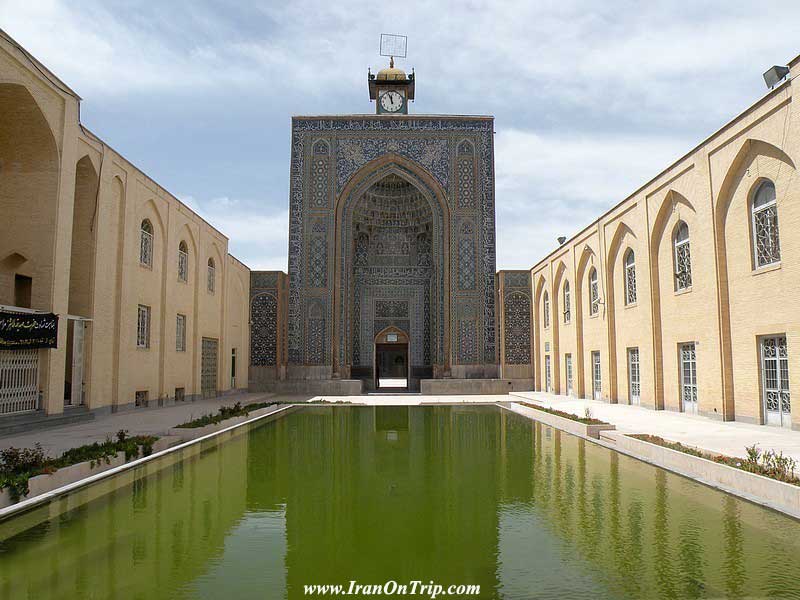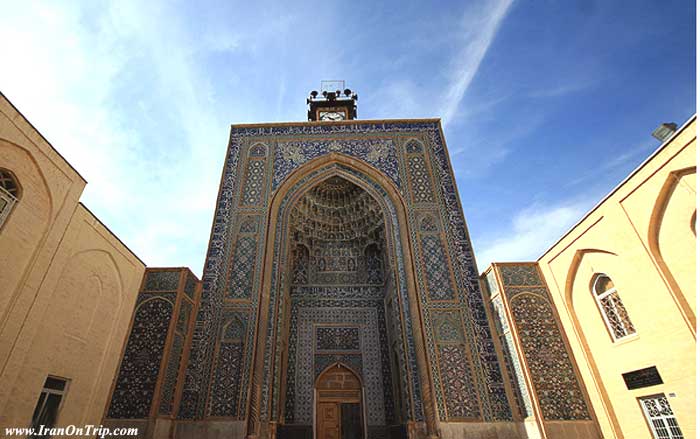Kerman Jame Mosque

The Friday mosque of Kerman is located in the prominent city of Kerman, which was established almost a thousand kilometers southeast of Tehran on an important crossroads of mercantile activities connecting north to south and west to east. This location led to the emergence of its famous, vibrant bazaar. The bazaar begins at the Friday mosque's rear portal and extends along the east-west axis, ending at the Arg Square. The Friday mosque of Kerman was built in 1350 by Amir Mobarezeddin Mohammad-e-Mozaffari-e-Meybodi- Yazdi under the Muzaffarids, who pushed away the Il Khanids after Abu Sa'id's death in 1335 and established their own dynasty, ruling central Iran from 1314 to 1393. The Friday mosque is the earliest surviving example of Muzaffarid architecture.
Following the ideal four-iwan plan, and evoking the Friday mosque at Yazd (built in 1324 under the Il Khanids, and later augmented in 1365 under the Muzaffarids), the Friday mosque of Kerman comprises a rectangular court (40 meters by 32 meters) surrounded by a one-story arcade with four iwans placed at the center of each side. Only the southern main iwan is flanked by additional galleries on the second floor. It rises higher than the other three open iwans facing the court and is both wider and deeper (10 meters by 15 meters). Unlike the mosque at Yazd, the southern main iwan does not precede a closed domed chamber, but opens the hall behind it to the court. The eastern and western iwans are located on the cross axis and are both rectangular (5 meters by 12 meters). The main entrance to the mosque is located to the north and is emphasized by its soaring portal iwan (20 meters high) opposite a city square with a central pool. Two succeeding spaces lead through this portal iwan to the mosque's court: an intermediary room, 4 meters square and surmounted by a dome, and an iwan facing the court. Two additional entrances are found on the south and west, extending beyond the rectangular perimeter of the mosque.

The mihrab was installed in the sixteenth century, whereas the qibla wall and the two side walls date from the original construction. The mihrab is a half-octagonal niche in the qibla wall and is surmounted by a semi-dome comprising two muqarnas tiers of tile mosaics of arabesque motifs placed on top of a marble dado. The mihrab's arch is framed by a rectangular frame with an inscription band flanked by two rectangular panels of glazed tile mosaics of geometric arabesque motifs. Another inscription band marks the joint between the prayer hall's walls and the room's pointed barrel vault, which is decorated with glazed terracotta in yellow and blue. The two walls adjacent to the qibla wall have only a marble dado on their base without any further ornamentation. Column-bounded prayer halls (16 meters by 24 meters) are integrated in the design and extend behind the arcade, aligning with the exterior walls of each of the four iwans (except part of the northern wall) and forming a rectangular outer perimeter of the mosque.
Because the mosque dates from the fourteenth century, its continuous tile mosaic is limited to certain areas-- the main portal and the facing of the arcade-- and is restricted to a four-color palette (white, yellow, and dark and light blue). In the court, tile mosaic in geometric patterns cover the arcade's piers and the upper edge of the arcade's frieze; the arcade's spandrels are decorated with arabesque vegetal decoration of tile mosaic. The iwan facing the court on the north is framed by a geometric arabesque pattern of tile mosaic inscribed into a geometric inscription band composed of rectangular tile mosaic pieces. It is surmounted by a semi-dome ornamented with a geometric arabesque pattern in white and dark blue inscribing floral patterns and descending from a medallion at the top of the semi-dome.
The main portal iwan is decorated with an extraordinary variety of rectangular panels of geometric, floral, and vegetal motifs. An inscription band in white script on a dark blue background frames the external perimeter of the iwan; floral ornament fills the spandrels' areas. The inner wall of the iwan, where the entrance opening is located, is covered by multiple frames of geometric panels in tile mosaic on top of which an inscription band runs horizontally at the center of the iwan's elevation. The iwan is crowned by a semi-dome of exquisite multi-tiered muqarnas units that ascend to a sunburst medallion on top of the semi dome. The arch of the iwan comprises a cable molding frame, inscription band, and another geometric frame. The square room behind the portal iwan is surmounted by a dome of muqarnases of alternating glazed and unglazed terracotta. An inscription band of tile mosaic runs along the room's frieze, above which four windows with a grill are at the center of each wall. The Friday mosque of Kerman continues to draw visitors and historians for its location, design, and ornamentation.
.....
.....
.....

.jpg)



























